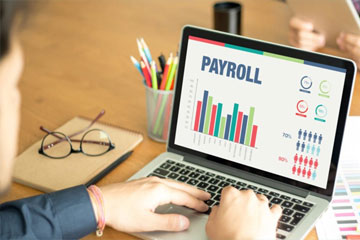
As businesses continue to evolve and embrace digital transformation, payroll processes are becoming increasingly automated and streamlined. In this blog, we’ll explore the key trends shaping the future of payroll and highlight the role of online payroll software in improving efficiency, accuracy, and overall employee satisfaction. If you’re looking for the best payroll management software or interested in the latest developments in payroll software systems, this post will provide valuable insights to help you stay ahead of the curve.
1. Automation and Artificial Intelligence in Payroll Software
One of the biggest trends in the future of payroll is automation. Modern payroll software systems are leveraging artificial intelligence (AI) to automate tasks such as tax calculations, employee deductions, and compliance with changing tax laws. This reduces the risk of human error, saves time, and ensures that businesses stay compliant with regulatory requirements.
AI-powered systems can even predict payroll trends, helping businesses make data-driven decisions about labor costs and budget planning. As automation continues to evolve, we can expect even more advanced features in payroll management software, making payroll processing faster and more efficient.
2. Cloud-Based Payroll Solutions for Greater Accessibility
Cloud technology is another significant trend in the world of payroll. Cloud-based payroll software provides businesses with the flexibility to manage payroll from anywhere, at any time. This trend is especially beneficial for remote teams, as it allows payroll managers to access critical information securely from any device, whether in the office or working from home.
Using a cloud-based payroll solution means automatic updates and seamless integration with other business systems like accounting or HR platforms. If you’re looking for the best payroll management software to support remote or hybrid work environments, cloud-based systems should be at the top of your list.
3. Integration with HR and Time-Tracking Systems
In the future, payroll software will be more integrated with other business systems, such as human resources (HR) and time-tracking solutions. Integrating payroll software systems with HR platforms allows for better synchronization between employee data, attendance, and payroll. This integration minimizes manual data entry, reduces errors, and makes payroll processing smoother.
For instance, when an employee requests time off, the payroll software will automatically adjust their pay based on the hours worked, deductions, or paid time off (PTO). This seamless integration will help businesses improve accuracy, speed up payroll processing, and ensure that employees are paid on time without complications.
4. Enhanced Security Features to Protect Sensitive Data
As cyber threats continue to grow, payroll management software is evolving to offer enhanced security features. Businesses are increasingly focused on protecting sensitive employee data, such as social security numbers, bank account details, and tax information.
Future payroll software systems will feature advanced encryption, multi-factor authentication (MFA), and role-based access control (RBAC) to ensure that only authorized personnel can access payroll data. For companies looking to protect their employees' information, these security advancements will be crucial in preventing data breaches and maintaining compliance with privacy laws.
5. Self-Service Portals for Employees
Employee self-service features are becoming more common in modern payroll software systems. These portals allow employees to access their pay stubs, track their earnings, view tax documents, and update personal information without needing to contact HR or payroll administrators.
In the future, these self-service portals will likely include more functionality, such as direct communication with payroll teams, real-time notifications about upcoming payments, and the ability to manage benefits and deductions. This self-service trend empowers employees, reduces administrative workloads, and enhances overall payroll transparency.
6. Compliance with Changing Regulations
As tax laws and labor regulations continue to evolve, businesses need payroll software systems that can quickly adapt to these changes. The best payroll management software solutions are equipped with features that automatically update to reflect changes in tax rates, minimum wage laws, and other regulatory requirements.
In the future, we can expect more advanced compliance features, including real-time alerts when legislation changes, ensuring that businesses never miss important updates. This reduces the administrative burden of staying compliant and minimizes the risk of penalties for non-compliance.
7. Mobile Accessibility for On-the-Go Payroll Management
With the rise of mobile technology, businesses will increasingly adopt payroll software systems with mobile apps. These mobile solutions will enable payroll managers to process payroll, approve time off requests, and access payroll data from their smartphones or tablets.
In the future, mobile accessibility will become a crucial feature for businesses of all sizes, allowing managers and employees to access payroll information instantly, even when they are on the go. Whether you're managing a team across different locations or need to make quick adjustments, mobile payroll systems will ensure that business operations run smoothly.
8. Data Analytics and Reporting for Informed Decision-Making
Another trend that will shape the future of payroll is the increased use of data analytics. Payroll software systems are evolving to provide detailed insights into payroll costs, employee compensation trends, and workforce productivity. With built-in reporting tools, businesses can track and analyze payroll data to make better-informed decisions about budgeting, hiring, and employee retention.
Advanced analytics features will give payroll managers and business leaders the ability to forecast payroll trends, identify cost-saving opportunities, and monitor the financial health of their organizations. As data-driven decision-making becomes more important, the best payroll management software will provide valuable insights that support strategic planning.
Conclusion: The Future of Payroll is Digital and Data-Driven
The future of payroll lies in the seamless integration of payroll software systems, automation, cloud-based solutions, and data-driven insights. As businesses continue to adopt these innovative technologies, payroll processing will become more efficient, accurate, and secure. By choosing the best payroll management software, organizations can streamline their payroll operations, reduce errors, and enhance employee satisfaction.
If you haven’t yet made the switch to modern payroll solutions, now is the time to explore the best online payroll software for your business. Embrace the trends shaping the future of payroll and stay ahead in an increasingly digital world.












